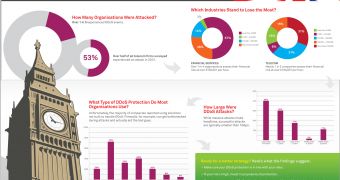A new study published today by Neustar – a company that provides real-time information and analysis to Internet, telecoms, entertainment and financial services industries – shows that 22% of United Kingdom companies experienced a disruptive distributed denial-of-service (DDOS) attack in 2012.
It’s worth noting that the number of organizations targeted by DDOS attacks is lower than in the US, where 35% of companies reported suffering such attacks.
In the UK, 37% of the attacks lasted for over 24 hours, while 22% of them lasted for over one week.
Telecommunications companies were the most targeted (53%), followed by ones from e-commerce (50%) and online retail (43%) sectors. In comparison, in the US, the financial sector was most targeted.
When it comes to the harm caused by DDOS attacks, financial services and telecoms companies suffer the most.
26% of the attacks against the financial sector have resulted in losses of over £100,001 ($150,000 / €115,000) per hour.
While cybercriminals have come up with techniques that allow them to launch massive attacks, 70% of the ones recorded in the UK last year were under 1Gbps.
Finally, it’s worth noting that 20% of the surveyed UK companies have no DDOS protection mechanisms in place.
“DDoS attacks will continue to be part of the modern threat landscape because they are easy and relatively low-cost to perpetrate. They continue to be a threat to both large and small firms in all industries,” said Alex Berry, Neustar senior vice president, Enterprise Services.
“Some of the recent large attacks have opened doors for even more malicious attackers to adopt similar tactics and Neustar fully expects to see the impacts of these attacks grow in line with their increasing complexity,” Berry added.
“As in North America, our survey has found that UK companies are hoping traditional defences will suffice, but given the frequency of attacks and the impact when sites go dark, such hopes are often badly misplaced.”
The complete study is available here. For a summary, check out the infographic.

 14 DAY TRIAL //
14 DAY TRIAL //